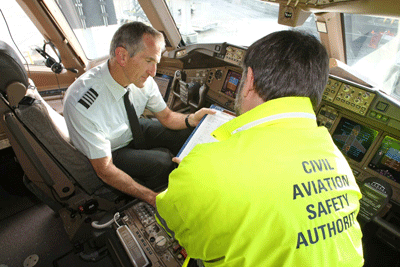CASA flies into paperless future

CASA chief information Officer Simon Denby is underway with a major program to bring Australia’s Civil Aviation Safety Authority into the 21st Century using advanced middleware and workflow automation.
The business of flight is one of the most heavily regulated industries there is, and with regulation comes a truckload of forms to fill out. Whether you are an aspiring pilot, an airline looking to get an airworthiness certificate for your aircraft, or a college seeking accreditation to train air traffic controllers, there is no shortage of paperwork to complete.
Until recently, this resulted in a mountain of physical paperwork for officers of Australia’s Civil Aviation Safety Authority, which has a permanent staff of 600, another 200 contract staff and a large physical call centre of almost 100 operators based in Canberra.
Until a move to electronic operations in 2008, all of more than 70 forms and applications on the CASA Web site were downloaded, printed and submitted via post.
CASA chief information Officer Simon Denby admits that CASA had a fairly antiquated model of doing business, but three major programs are seeking to reverse the status quo.
The first is a Gateway project to deliver online portals for pilots and engineers, and another for the airlines that transact business with CASA at a B2B level.
CASA is also building what it calls a single service centre to support standardised industry reference material on aircraft.
“We are also looking towards deploying VOIP and thin client operation so we can operate a virtual call centre and offer staff the ability to work from home,” said Denby.
CASA’s customer relationship management application is Siebel, running on an Oracle database, with Office 2003 on Windows XP and Exchange 2003 email.
Compuware ChangePoint is being used to develop workflow for any process that flows through CASA.
TRIM is CASA’s records management platform although up until two years ago all records were paper-based. Each application now creates a unique TRIM file and all the supporting documents including emails are dropped into the same TRIM file.
 Intelledox intelligent forms technology is being deployed to build input PDF forms to begin processes and then at the other end to generate output templates.
Intelledox intelligent forms technology is being deployed to build input PDF forms to begin processes and then at the other end to generate output templates.
“These were previously built individually in Adobe LiveCycle which became very expensive to maintain,” said Denby.
“Individual application form workflows could cost tens of thousands to generate, using experienced programmers. Now our junior staff can generate templates that are easy to change.
“Moving to Intelledox provided us with a much more agile platform. If there’s a change in government policy or something in the aviation industry changes, we can now change them very quickly.
“Currently there’s a few LiveCycle forms that you can complete online but what we don’t have right now is any ability at all to take that data into a workflow system. “
Call centre staff answer the telephone and re-key data in that arrives on paper. About two thirds of the forms are downloaded, printed then completed by hand.
“Our staff have to re-key the data from the PDF into our internal system, so we don’t gain any benefit at all currently from people submitting their application online.
“It’s good for the user but we don’t gain any benefit whereas with Intelledox the data goes directly into the workflow or customer relationship management system. That’s actually kicking off the transaction itself.”
CASA is hoping that it can move two thirds of its forms transactions to an online model, and is exploring the potential to accept digital signatures. Although certain critical forms such as medical accreditation must be submitted on paper.
“We don’t expect we’ll be able to move 100% of our forms online, the aviation industry is full of older generation people so I think there’ll always be a number who want to fill in forms and sign them and send them back with a cheque stapled to them,” said Denby
By prepopulating forms with data based on every applicant’s unique Aviation Reference Number, the IT revolution underway at CASA is also making the process simpler for applicants.
